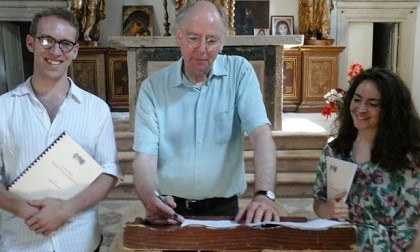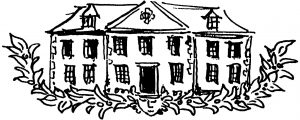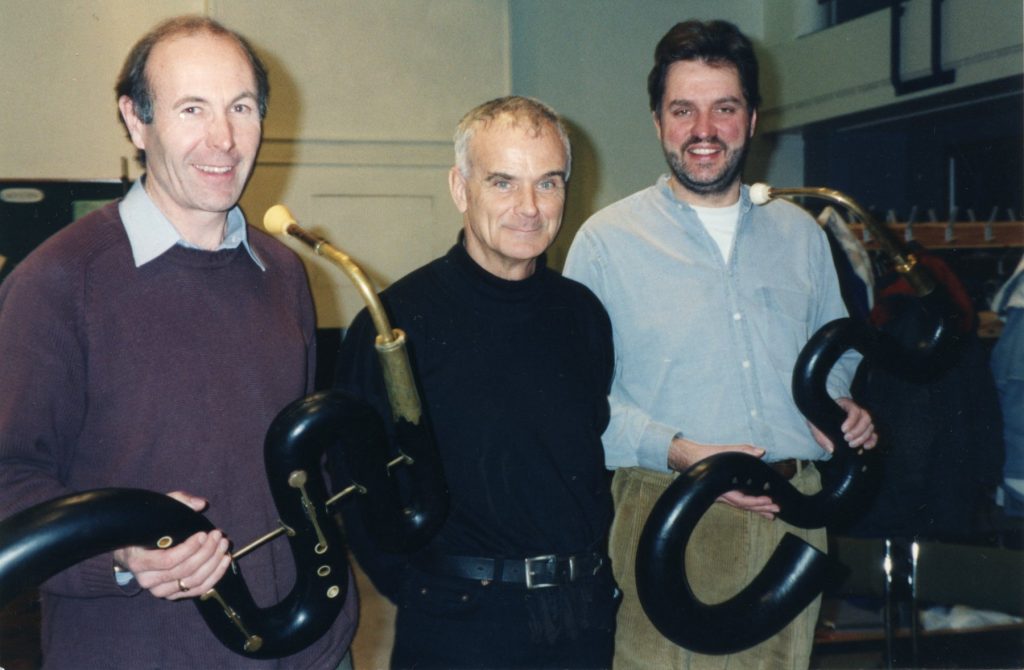September: Our main summer school next year will be in Edinburgh in the middle of July. The young conductor, singer and musicologist Rory McCleery will direct a programme of music found in Scottish 16th century sources, including Robert Carver’s 19-part O bone Jesu.
Rory is someone we had been wanting to meet for some time, and it turned out that he was just as keen to meet us. By a nice coincidence his father-in-law is my fellow serpent player Stephen Wick. When Rory came to Lacock to talk about the Edinburgh week I was able to dredge up a photograph taken when Steve and I – alongside some other oddities – joined the BBC Symphony Orchestra in a recording of Peter Maxwell Davies’s opera Taverner, some time back in the nineties. The complex atonal score was quite a challenge for the small band of early instrumentalists, whose normal fare was nothing more frenetic than a pavane or canzona. Our blood ran cold when after the first run-through the conductor Oliver Knussen, a great bear of a man who died before his time last year, turned to the cornettist and asked if a certain semiquaver was marked with a flat as in his score, because what he heard was a natural. Nothing escaped his ear. Some of the upper parts were impossibly complex, but mercifully for Steve and me the serpent parts were relatively sedate.
The forty-part week with Gabriel Crouch (and Lacock scholars Robin Datta and Connor Cobb) in Ludlow was an exhilarating experience and our performance in the round was much appreciated by the gratifyingly large audience. And most recently we were in Jimena de la Frontera for Patrick Craig’s programme of psalm settings. I’ve just realised that our first venture in this characterful part of the world was a quarter of a century ago. Andalusians love a bit of noise: one morning it sounded as if the house removers across the narrow street from the church were throwing furniture onto the pavement from an upper window. It seemed rather fitting to be singing ‘Lord let me know mine end and the number of my days’ with what sounded like the destruction of Valhalla going on in the street outside.
June: The second is a return to Tobago in February for another Singing in Castara directed by Justin Doyle, assisted by young conductor and former Lacock scholar Sarah Latto. We never intended it to be an annual event (and there almost certainly won’t be one in 2021), but once you’ve been there and escaped the tail end of a northern winter it’s very easy to get into the habit. Justin always comes with three generations of his family and this year will be the last before his boys are in full-time school. That was one excuse for a return visit: the other was a suggestion by some of the villagers that we get together with local musicians for a one-day festival at the end of our course. ‘The Castara Song Harvest’ will feature our group along with a small number of Tobagonian choirs, the village African drumming ensemble, a steel band and will showcase some of their culinary traditions such as barbecued fish from the bay and bread baked in clay ovens.
For the Ludlow Summer School coming up in July Gabriel Crouch suggested, to go alongside the Tallis and Striggio 40-parters, an anonymous Spanish setting of the Ten Commandments set as a canon for ten four-part choirs. Panic set in in April when it dawned on us that the only scholar known to have edited the work wasn’t intending to be outstandingly cooperative. The only thing for it was to edit the work myself. Soon I realised some of the difficulties: the only copy of the book it was published in is in a library in Madrid, the source of the text was unknown and to cap it all it is in an obscure system of notation without clefs or note lengths called Spanish number tablature. It is known only from three publications in the mid 16th century, so it was a bit like learning a language which has just three speakers. Luckily any ten-part canon is going to be a repetition of a simple chordal pattern and it all fell into place quite easily. The internet led me quickly to facsimiles of both the music and the text. The Ludlow group is now just about quorate – we may be able to slip in the odd extra voice so let us know if you still want to join us in July.
Before the Ludlow Spem in alium I get to sing the work with Ex Cathedra in Bath Abbey on the 9th of July. This is an excellent choir made up of young professionals and students of the Birmingham conservatoire, filled out when the occasion demands by some of Jeffrey Skidmore’s old mates. We usually rehearse at the Birmingham Oratory, where once Jeffrey got the librarian to let him and me inspect the manuscript of The Dream of Gerontius. On another occasion I was walking through the church in my concert black trying to find the rehearsal (it was in the adjacent hall) when a very anxious-looking Irish lady rushed up to me with the unexpected question: “Father, are there any relics of Cardinal Newman here?”
We’ve had some good courses recently. Aidan Oliver was a big hit at the Corsham Winter School. Unfortunately, others have spotted him too and has just been made chorus master at Glyndebourne, a more-or-less full time job, so I don’t know when we will be able to get him back. We had an excellent group in Tobago. There was a memorable moment in the final concert when – in mid Kyrie – we were almost knocked sideways by a blast of reggae from a house a few doors away. Luckily one of the village elders was in our audience. He went and had ‘a quiet word’ and calm was miraculously resumed.
January: The Lacock Scholars are as active as ever; many of you will already have their latest CD, Duarte Lobo’s six-voice Requiem coupled with commemoration motets. It can be bought from their web site www.lacockscholars.org . I was surprised to see a two page on Tallis and Byrd in the Christmas edition of The Economist. All their articles are anonymous and I haven’t checked, but it must have been the work of Lacock Scholar Soumaya Keynes, who is on their staff. Here she is at the 2015 Trogir Music Week in Croatia, with (centre) conductor Andrew Parrott and co-scholar Stuart O’Hara.


